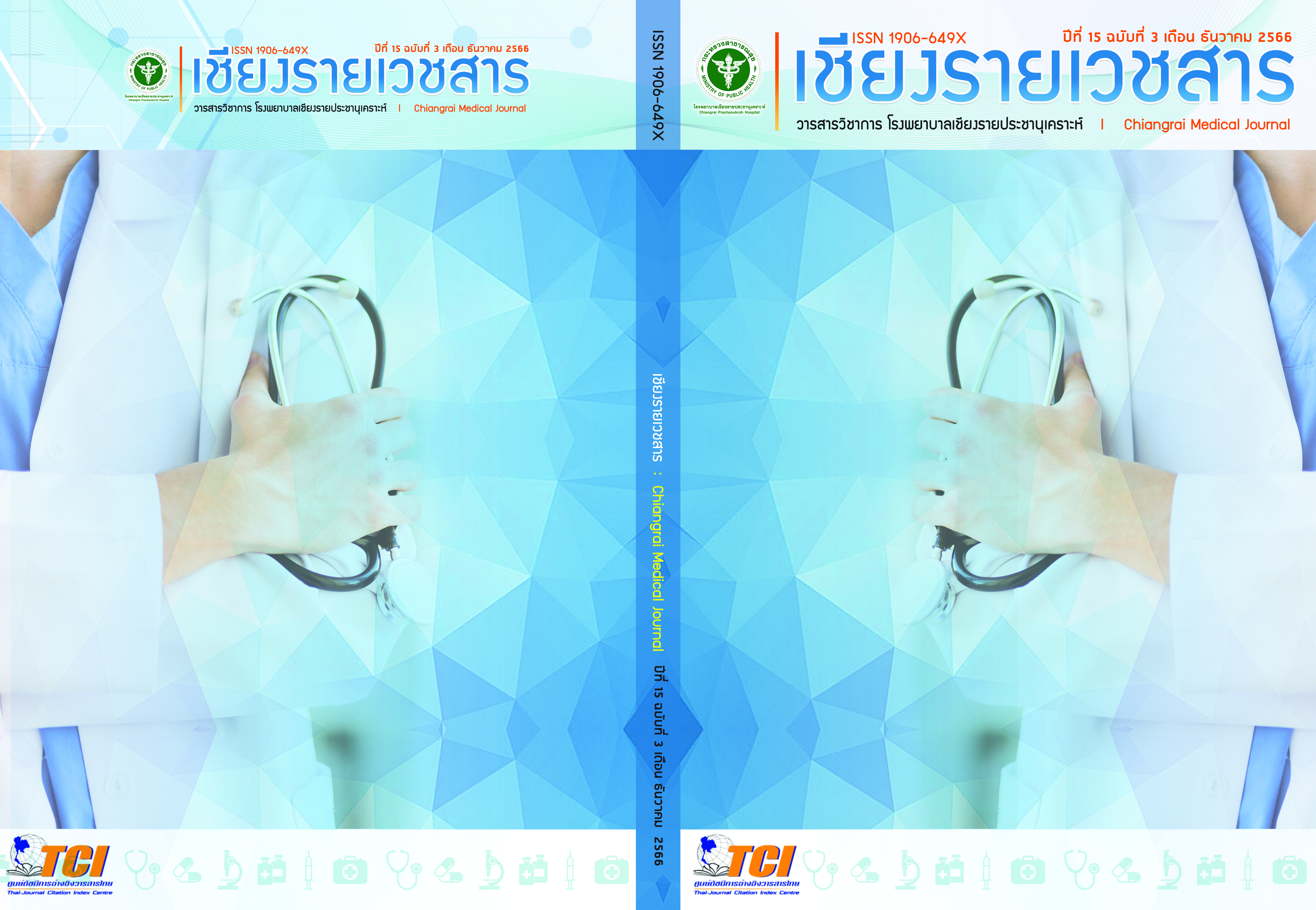ความสัมพันธ์ระหว่างปริมาตรตับที่คาดว่าจะเหลือหลังการผ่าตัดโดยการคำนวณจากภาพเอกซเรย์คอมพิวเตอร์ก่อนการผ่าตัดและภาวะตับวายเฉียบพลันหลังการผ่าตัด
Main Article Content
บทคัดย่อ
ความเป็นมา : การผ่าตัดตับ (hepatectomy) เป็นการรักษาผู้ป่วยมะเร็งตับระยะเริ่มต้น ภาวะตับวายหลังการผ่าตัด (post-hepatectomy liver failure) เป็นหนึ่งในภาวะแทรกซ้อนร้ายแรงหลังการผ่าตัดตับ และมีความเกี่ยวข้องกับปริมาตรตับที่คงเหลือหลังการผ่าตัด ในปัจจุบันนี้เราสามารถใช้เทคโนโลยีเอกซเรย์คอมพิวเตอร์เพื่อคำนวณปริมาตรตับที่เหลือหลังการผ่าตัด (future liver remnant) เพื่อประเมินผู้ป่วยก่อนเข้ารับการรักษาโดยการผ่าตัดได้
วัตถุประสงค์: เพื่อศึกษาความสัมพันธ์ระหว่างปริมาตรตับที่เหลือหลังการผ่าตัดที่คำนวณด้วยเครื่องเอกซเรย์คอมพิวเตอร์ และอัตราการเกิดภาวะตับวายหลังการผ่าตัด
วิธีการศึกษา : การวิจัยครั้งนี้เป็นการศึกษาย้อนหลัง (retrospective study) โดยสืบค้นเวชระเบียนอิเล็กทรอนิกส์ของผู้ป่วยที่ได้รับการผ่าตัดตับในโรงพยาบาลเชียงรายประชานุเคราะห์ ตั้งแต่เดือนมกราคม พ.ศ. 2561 ถึงเดือนเมษายน พ.ศ. 2564 ข้อมูลที่ใช้ในการศึกษา ได้แก่ ปริมาตรตับที่เหลือหลังการผ่าตัด และปัจจัยอื่น ๆ เกี่ยวข้องกับภาวะตับวายหลังการผ่าตัด ถูกนำมาวิเคราะห์ทางสถิติด้วยการวิเคราะห์แบบการถดถอยลอจิสติกเชิงพหุ (Multiple Logistic Regression)
ผลการศึกษา : ผู้ป่วยทั้งหมด 50 ราย พบภาวะตับวายเฉียบพลันหลังผ่าตัด 10 ราย (ร้อยละ 20) โดยมีค่าเฉลี่ยของปริมาตรตับที่เหลือหลังการผ่าตัดต่ำกว่าผู้ป่วยที่ไม่มีภาวะดังกล่าว ค่าเฉลี่ยของปริมาตรตับที่เหลือหลังการผ่าตัดอยู่ที่ร้อยละ 35.87 และ 66.41 ตามลำดับ มีค่านัยสำคัญทางสถิติ (p value) น้อยกว่าหรือเท่ากับ 0.001 ค่าจุดตัด (cut-point value) ของปริมาตรตับที่เหลือหลังการผ่าตัดที่ร้อยละ 45.94 เป็นค่าที่มีความไว (sensitivity) และความจำเพาะ (specificity) ที่ดีที่สุดในการทำนายการเกิดภาวะตับวายหลังการผ่าตัด ค่าความไวอยู่ที่ร้อยละ 90 และความจำเพาะอยู่ที่ 87.5 ในกรณีที่ผู้ป่วยมีปริมาตรตับที่เหลือหลังการผ่าตัดน้อยกว่าค่าจุดตัด อัตราส่วนในการเกิดภาวะตับวายหลังการผ่าตัดคือ 60.72 (Adj. Odds ratio เท่ากับ 60.72, 95% CI เท่ากับ 2.72-1,352 และ p value เท่ากับ 0.009)
สรุปและข้อเสนอแนะ : การประเมินผู้ป่วยร่วมกับการใช้ค่าปริมาตรตับที่เหลือหลังการผ่าตัดที่คำนวณด้วยเครื่องเอกซเรย์คอมพิวเตอร์ในระยะเวลาก่อนการเข้ารับการผ่าตัด จัดว่าเป็นวิธีที่มีความสำคัญซึ่งสามารถลดอัตราการเสียชีวิตได้ ในกรณีที่ผู้ป่วยมีปริมาตรตับที่เหลือหลังการผ่าตัดต่ำกว่าร้อยละ 45.94 ควรเพิ่มหัตถการก่อนการผ่าตัด เช่น Portal vein embolization) หรือportal vein ligation เพื่อเพิ่มปริมาตรตับที่เหลือหลังการผ่าตัด
Article Details

อนุญาตภายใต้เงื่อนไข Creative Commons Attribution-NonCommercial-NoDerivatives 4.0 International License.
เอกสารอ้างอิง
National Cancer Institute. Department of Medical Service. Ministry of Public Health [Internet]. 2013-2017. [cited 2023 May 5]; Available from: https://www.nci.go.th/th/cancer_record/cancer_rec1.html
Jaeck D, Bachellier P, Oussoultzoglou E, Weber JC, Wolf P. Surgical resection of hepatocellular carcinoma. Post-operative outcome and long-term results in Europe: an overview. Liver Transpl. 2004;10(2 Suppl 1):S58-63.
Dinant S, de Graaf W, Verwer BJ, Bennink RJ, van Lienden KP, Gouma DJ, et al. Risk assessment of posthepatectomy liver failure using hepatobiliary scintigraphy and CT volumetry. J Nucl Med. 2007;48(5):685-92.
Balzan S, Belghiti J, Farges O, Ogata S, Sauvanet A, Delefosse D, et al. The "50-50 criteria" on postoperative day 5: an accurate predictor of liver failure and death after hepatectomy. Ann Surg. 2005;242(6):824-8.
Pulitano C, Crawford M, Joseph D, Aldrighetti L, Sandroussi C. Preoperative assessment of postoperative liver function: the importance of residual liver volume. J Surg Oncol. 2014;110(4):445-50.
van den Broek MA, Olde Damink SW, Dejong CH, Lang H, Malagó M, Jalan R, et al. Liver failure after partial hepatic resection: definition, pathophysiology, risk factors and treatment. Liver Int. 2008;28(6):767-80.
Guglielmi A, Ruzzenente A, Conci S, Valdegamberi A, Iacono C. How much remnant is enough in liver resection? Dig Surg. 2012;29(1):6-17
Farges O, Malassagne B, Flejou JF, Balzan S, Sauvanet A, Belghiti J. Risk of major liver resection in patients with underlying chronic liver disease: a reappraisal. Ann Surg.
;229(2):210-5.
Balzan S, Nagarajan G, Farges O, Galleano CZ, Dokmak S, Paugam C, et al. Safety of liver resections in obese and overweight patients. World J Surg. 2010;34(12):2960-8.
Vauthey JN, Pawlik TM, Ribero D, Wu TT, Zorzi D, Hoff PM, et al. Chemotherapy regimen predicts steatohepatitis and an increase in 90-day mortality after surgery for hepatic colorectal metastases. J Clin Oncol. 2006;24(13):2065-72.
Schindl MJ, Redhead DN, Fearon KC, Garden OJ, Wigmore SJ. The value of residual liver volume as a predictor of hepatic dysfunction and infection after major liver resection. Gut.
;54(2):289-96.
Ogasawara K, Une Y, Nakajima Y, Uchino J. The significance of measuring liver volume using computed tomographic images before and after hepatectomy. Surg Today. 1995;25(1):43-8.
Ribero D, Abdalla EK, Madoff DC, Donadon M, Loyer EM, Vauthey JN. Portal vein embolization before major hepatectomy and its effects on regeneration, resectability and outcome. Br J Surg. 2007;94(11):1386-94.
Sarakarn P, Munpolsri P. Optimal cut-off points for receiver operating characteristic (ROC) curve analysis in developing tools of health innovations: example using STATA. Thai Bull Pharm Sci. 2021;16(1):93–108.
Shoup M, Gonen M, D'Angelica M, Jarnagin WR, DeMatteo RP, Schwartz LH, et al. Volumetric analysis predicts hepatic dysfunction in patients undergoing major liver resection.
J Gastrointest Surg. 2003;7(3):325-30.
Asenbaum U, Kaczirek K, Ba-Ssalamah A, Ringl H, Schwarz C, Waneck F, et al. Post-hepatectomy liver failure after major hepatic surgery: not only size matters. Eur Radiol.
;28(11):4748-56.
Khan AS, Garcia-Aroz S, Ansari MA, Atiq SM, Senter-Zapata M, Fowler K, et al. Assessment and optimization of liver volume before major hepatic resection: Current guidelines and a narrative review. Int J Surg. 2018;52:74-81.
Eshmuminov D, Raptis DA, Linecker M, Wirsching A, Lesurtel M, Clavien PA. Meta-analysis of associating liver partition with portal vein ligation and portal vein occlusion for two-stage hepatectomy. Br J Surg. 2016;103(13):1768-82.


